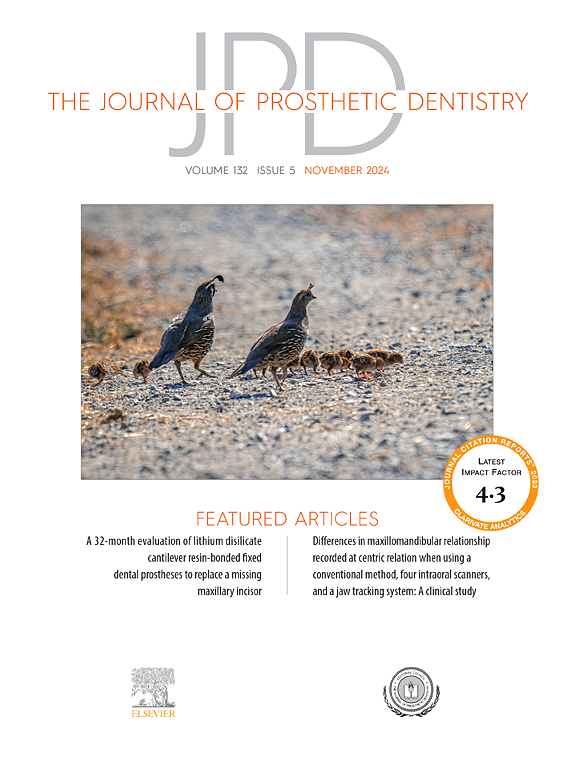Effect of surface treatment protocols on the maintenance of a light-activated characterization coating for 3D printable composite resin
IF 4.8
2区 医学
Q1 DENTISTRY, ORAL SURGERY & MEDICINE
引用次数: 0
Abstract
Statement of problem
Effective methods for improving the maintenance of light-activated characterization coatings for 3-dimensionally (3D) printable composite resin need to be investigated, and an appropriate working protocol must be established.
Purpose
The purpose of this in vitro study was to determine the effect of treatment protocols on the maintenance of characterization coating in 3D printed dental restorations by focusing on preserving color stability and gloss retention to support clinical longevity.
Material and methods
Fifty disk-shaped (Ø12×2 mm) specimens were prepared with a 3D printable composite resin and divided into 10 groups (n=5) according to the surface treatment (aluminum oxide airborne-particle abrasion, phosphoric acid, silane, or adhesive). They were coated with a light-activated characterization and a sealant. Color stability, surface roughness, and gloss tests were conducted before and after a toothbrushing abrasion simulation (20 000 cycles). Color change (ΔE00, based on the CIE2000 standard) was measured using a spectrophotometer, surface roughness (Ra) with a profilometer, and gloss (GU) with a glossmeter. Two-way repeated measures analyses of variance (ANOVA) followed by Tukey post hoc tests (α=.05) were used to analyze the results for roughness and gloss before and after toothbrush abrasion. One-way ANOVA followed by the Tukey post hoc test was used for color difference.
Results
Before the brushing simulation, the group that used the complete surface treatment protocol exhibited the lowest Ra values. After brushing, no statistically significant differences were observed (P>.05). Groups to which adhesive had not been applied and those treated exclusively with characterization and sealant exhibited the highest gloss values before the simulation. However, no difference in gloss values was found among the groups after brushing, except for the control group, which showed the lowest values. High color changes were observed in groups where adhesive or silane was applied separately without abrasion beforehand.
Conclusions
Overall, the surface treatments applied resulted in lower roughness and higher gloss. However, they led to treatments with reduced color stability compared with those without the characterization agent.
表面处理方案对3D打印复合树脂光活化表征涂层维护的影响。
问题说明:需要研究改善三维(3D)可打印复合树脂光活化表征涂层维护的有效方法,并且必须建立适当的工作方案。目的:本体外研究的目的是确定治疗方案对3D打印牙齿修复体中表征涂层维持的影响,重点是保持颜色稳定性和光泽保持,以支持临床寿命。材料和方法:采用3D打印复合树脂制备50个圆盘状(Ø12×2 mm)试样,根据表面处理(氧化铝气载颗粒磨损、磷酸、硅烷或粘合剂)分为10组(n=5)。它们被涂上了光活化表征和密封胶。颜色稳定性、表面粗糙度和光泽测试在刷牙磨损模拟之前和之后进行(20,000次循环)。用分光光度计测量颜色变化(ΔE00,基于CIE2000标准),用轮廓仪测量表面粗糙度(Ra),用光泽度仪测量光泽度(GU)。采用双向重复测量方差分析(ANOVA)和Tukey事后检验(α= 0.05)对牙刷磨损前后的粗糙度和光泽进行分析。色差采用单因素方差分析和Tukey事后检验。结果:模拟刷牙前,采用完整表面处理方案的组Ra值最低。刷牙后,差异无统计学意义(P < 0.05)。未使用粘合剂的组和仅使用表征剂和密封剂处理的组在模拟前表现出最高的光泽值。然而,刷牙后各组之间的光泽值没有差异,除了对照组的光泽值最低。在事先不磨损的情况下,分别使用粘合剂或硅烷的组观察到高颜色变化。结论:总的来说,表面处理的结果是粗糙度降低,光泽度提高。然而,与不含表征剂的处理相比,它们导致颜色稳定性降低。
本文章由计算机程序翻译,如有差异,请以英文原文为准。
求助全文
约1分钟内获得全文
求助全文
来源期刊

Journal of Prosthetic Dentistry
医学-牙科与口腔外科
CiteScore
7.00
自引率
13.00%
发文量
599
审稿时长
69 days
期刊介绍:
The Journal of Prosthetic Dentistry is the leading professional journal devoted exclusively to prosthetic and restorative dentistry. The Journal is the official publication for 24 leading U.S. international prosthodontic organizations. The monthly publication features timely, original peer-reviewed articles on the newest techniques, dental materials, and research findings. The Journal serves prosthodontists and dentists in advanced practice, and features color photos that illustrate many step-by-step procedures. The Journal of Prosthetic Dentistry is included in Index Medicus and CINAHL.
 求助内容:
求助内容: 应助结果提醒方式:
应助结果提醒方式:


